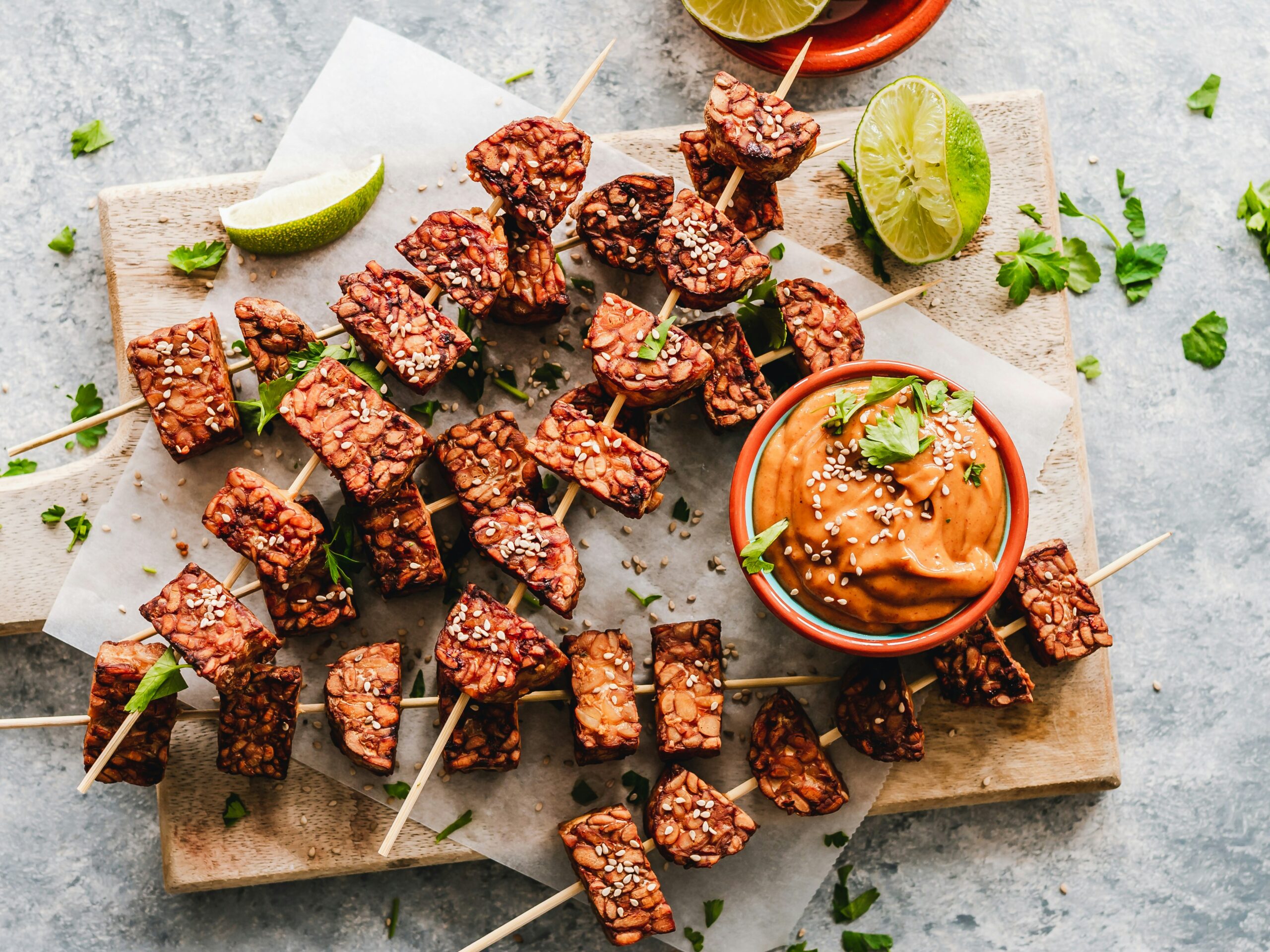Physical Address
304 North Cardinal St.
Dorchester Center, MA 02124
Physical Address
304 North Cardinal St.
Dorchester Center, MA 02124


What is tempeh, and should we all be eating more of this probiotic wholefood that just happens to be a complete protein?
Tempeh might look a little intimidating at first, but don’t let the appearance fool you. This dense, speckled brick of soybeans boasts an impressive nutritional value and has been eaten for centuries in Indonesia. Now widely available around the world, it’s still often misunderstood. Is it a meat alternative? A superfood? Something you’re supposed to boil, fry, or bake?
In reality, tempeh is all of those things… and yet none of them exactly. It’s a versatile, whole-soy product with a growing global following. If you’re not already on team tempeh, here’s what you need to know.
| Characteristic | Details |
| 🤔 What is it? | Fermented soy product made with Rhizopus mould |
| 🌍 Origin | Java, Indonesia |
| 📜 First documented | 1600s |
| 🧑🍳 Main ingredient | Whole soybeans |
| ⌛ Fermentation time | 24-48 hours |
| 👅 Flavour | Earthy, tangy, nutty, savoury |
| 💪 Complete protein? | Yes, approx. 19g per 100g |
| 🦠 Probiotics | Yes |
| 🌱 Dietary Info | Vegan, gluten-free |
| 🚫 Allergens | Soy |
Tempeh is made from soybeans fermented with a specific mould that binds the beans together into a firm, sliceable block. The result is a textured food with a mildly tangy, earthy taste and a satisfying bite.
Unlike tofu, which is made from soy milk, tempeh uses whole soybeans. This gives it a higher fibre content and more complex texture. So, what is tempeh good for? It can be sliced, cubed, crumbled, or marinated, and used in everything from wraps and stir-fries to salads and noodle bowls. You can even make it into bacon. (Yes, you heard that right.)

Tempeh originated in Java, Indonesia, and is still a staple across the region today. But now, it’s also showing up in supermarkets, meal kits, and restaurant menus everywhere, especially as more people look for wholefood, plant-based sources of protein.
To make tempeh, you need to ferment whole soybeans. First, you soak, dehull, and cook the beans until they’re soft. Then you mix them with a starter culture called Rhizopus oligosporus, a type of mould that’s completely safe to eat. Spreak the mixture into a shallow container and leave to ferment at around 30-37°C (85-98°F) for around 24-48 hours. Voila! You have tempeh.
During the fermenting time, the mould grows over and around the beans. It forms a dense white layer that holds everything together. This is what gives tempeh its firm texture and subtle tang.
Traditional Indonesian tempeh is typically wrapped in banana leaves and fermented naturally in the warm, humid climate. Commercial tempeh, on the other hand, is usually produced in stainless steel containers under strictly controlled conditions. The result is similar, though the flavour and microbial diversity can vary slightly between the two.
While soybeans are the most common base, you can also make tempeh with other legumes, grains, or a mixture of both. You might see versions made with chickpeas, black beans, lentils, barley, or even rice.
You’ll often hear tempeh and tofu mentioned in the same breath. They’re fantastic sources of protein and are both soy-based, after all (like hummus). However, they’re actually very different foods.
Tofu is made by coagulating (sorry!) soy milk into curds and pressing it into blocks. It has a soft, smooth texture and a very mild flavour. This makes it the perfect blank canvas for marinades, stir-fries, and soups. You can even blend silken versions into creamy salad dressings or desserts like chocolate mousse. On the other hand, freezing, defrosting, pressing, and baking tofu gives it a meaty, chewy texture.
We’ve already been over how tempeh is made—fermented whole soybeans bound together by mould. It’s more dense and has a serious nutty flavour. Because it’s made from whole means, it also contains more fibre and tends to be more filling.
Tempeh has the edge when it comes to gut health (thanks to the fermentation), iron, and micronutrients, too. Tofu is slightly lower in calories and fat. As plant foods, both are zero cholestreol.
| Nutrient (100g) | Tempeh (steamed/pasteurised) | Tofu (fresh) |
| Calories | 193 kcal | 55-145 kcal (silken vs firm) |
| Protein | 19g (38% DV) | 9g (18% DV) |
| Fat | 11g (14% DV) | 3g (2% DV) |
| – Saturated fat | 2g (11% DV) | 0.4 (2% DV) |
| – Trans fat | – | – |
| Carbohydrates | 9g (3% DV) | 2g (1%) |
| Fibre | 6g (24% DV) | <1g |
| Sodium | 9mg (0.4% DV) | 36mg (2% DV) |
| Iron | 3mg (34% DV) | 2mg (11% DV) |
| Calcium | 111mg (11% DV) | 176-350mg (18-35% DV) |
| Magnesium | 80mg (19% DV) | 30mg (7% DV) |
| Potassium | 412mg (9% DV) | 121mg (3% DV) |
| Vitamin B6 | 0.1-0.2mg (17% DV) | 0.1mg (6% DV) |
Note: Nutrition values vary slightly between brands and preparation methods. Tofu’s calcium content depends on how it’s set.
Tempeh is a wholefood, so it’s a great alternative to more refined or ultra-processed foods (UPFs). It’s also a natural source of probiotics and a complete protein, meaning it contains all nine essential amino acids your body needs but can’t make on its own.
When it comes to other nutrients, what is tempeh rich in? Here’s a quick run down:
Tempeh is also a source of copper, manganese, niacin, pantothenic acid, phosphorus, thiamine, and zinc.
Thanks to the fermentation process, tempeh is also easier to digest than unfermented soy. The mould (Rhizopus oligosporus) helps break down compounds like phytic acid, which normally reduce the absorption of minerals in legumes. That means your body may get more from each bite, especially when it comes to iron and zinc.
And while not all tempeh products are teeming with live cultures by the time they reach your plate (especially if pasteurised), they still contain prebiotics which feed your good gut bacteria.

You’ll usually find tempeh in the refrigerated section of health food shops, Asian supermarkets, or well-stocked grocery stores. You may also see it in a jar, in the dry food/cupboard or vegan/GF/specialist diet section. It looks a bit like a museum specimen, but don’t be put off! It’s also available online. Watch this space! The ETL team will be publishing local guides to help you find tempeh near you.
YES! Tempeh is a probiotic-rich, whole soy food that’s high in protein, fibre, iron, and other essential nutrients.
Technically, yes, if it’s been properly fermented and pasteurised. But realistically, you’re gunna want to cook it for the best taste and texture.
Not exactly. It has a nutty, savoury flavour that’s quite unlike anything else. It can mimic meat in some dishes, especially when marinated and cooked well. With the right spices and seasonings, you can turn it into bacon!
You can steam, pan-fry, bake, grill, or crumble tempeh into dishes. Steaming helps mellow the tangy flavour, and marinating adds depth.
Tempeh is often used as the primary protein in healthy bowls, wraps, sandwiches, salads, and more. It’s extremely versatile!
Tempeh is a satisfying, protein-packed staple with deep roots in Indonesia and big potential in the kitchen. It’s a quick, delicious way to add some probiotics to your diet and cover a good portion of your micros, too. Plus, it soaks up marinades like nobody’s business. Go on—get cooking!